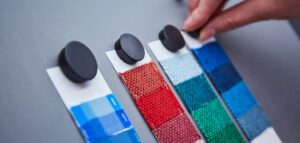Eco-Friendly EF Web Spunlace Nonwoven & Market Outlook
As industries shift toward sustainable development and eco-conscious materials, nonwoven fabrics are being redefined to meet both environmental and performance demands. Among the leading innovations is EF Web semi-cross embossed spunlace nonwoven, a fabric that not only delivers strength, softness, and absorbency but also aligns with global goals for environmental protection and resource efficiency.
This article focuses on the environmental advantages, performance benefits, and future market prospects of EF Web nonwovens, highlighting their role in shaping the next generation of sustainable textiles.
Eco-Friendly Raw Materials
EF Web spunlace nonwoven fabrics are produced from a range of natural and synthetic fibers. Common raw materials include wood pulp, cotton, viscose, and polyester, with blends tailored for specific performance needs.
Wood Pulp and Cotton: Renewable and biodegradable, offering softness and high moisture absorption.
Viscose: Derived from natural cellulose, adding smoothness and drape while remaining biodegradable.
Polyester: Enhances strength and durability, often used in combination with natural fibers.
By carefully selecting and blending these fibers, manufacturers can balance durability, performance, and environmental responsibility, ensuring the fabric meets diverse application requirements.
Environmental Performance
One of the strongest advantages of EF Web semi-cross embossed spunlace nonwoven is its environmental compatibility.
Biodegradability and Recyclability
Fabrics made primarily from natural fibers such as cotton, viscose, or wood pulp are biodegradable, breaking down naturally without leaving harmful residues. Even when polyester is blended for strength, many EF Web nonwovens can still be recycled, reducing waste in landfills.
Low Emissions in Production
Unlike chemically bonded nonwovens, the hydroentanglement process used for EF Web fabrics eliminates the need for adhesives and resins, minimizing chemical emissions and energy consumption. This ensures cleaner production and a lower carbon footprint.
Resource Efficiency
Bamboo pulp, wood pulp, and other fast-growing renewable fibers can be used as feedstock, reducing dependency on petroleum-based materials. This supports a circular economy model, where textiles are designed for reusability, recyclability, and compostability.
Role in Medical and Hygiene Applications
Sustainability is not just about environmental benefits—it also extends to human health and safety, areas where EF Web spunlace nonwoven excels.
Medical Uses
Surgical gowns and drapes benefit from the fabric’s breathability, comfort, and protective properties.
Face masks and respirators made from EF Web nonwovens offer reliable filtration with lower environmental impact.
Wound dressings and bandages combine softness with antibacterial protection, ensuring patient safety.
Hygiene and Personal Care
In hygiene products, the skin-friendliness and absorbency of EF Web nonwoven make it a superior choice:
Baby wipes and diapers remain gentle on infant skin while reducing chemical exposure.
Feminine hygiene pads and liners benefit from softness, breathability, and odor control.
Household wipes and towels offer effective cleaning without lint residue, while remaining biodegradable.
By combining performance with sustainability, EF Web nonwoven meets consumer demand for products that are both safe and environmentally responsible.
Performance Benefits and Market Differentiation
Beyond sustainability, EF Web spunlace nonwoven delivers performance advantages that allow it to stand out in competitive markets:
Durability: The semi-cross web design prevents tearing, ensuring reliability in demanding uses.
Absorbency: Embossed structures improve liquid uptake and retention.
Softness: Hydroentangled fibers create a gentle touch, critical for medical and hygiene products.
Versatility: Can be tailored for disposable or reusable products across industrial, medical, and consumer sectors.
These performance attributes give EF Web nonwoven a competitive edge over both traditional woven fabrics and conventional nonwovens.
Market Prospects and Global Demand
The global nonwoven market is projected to grow significantly, driven by hygiene, healthcare, and sustainable packaging. EF Web semi-cross embossed spunlace nonwoven is well-positioned to benefit from this trend.
Growth Drivers
Rising Hygiene Awareness – Post-pandemic demand for wipes, masks, and disposable protective gear remains strong.
Eco-Friendly Regulations – Governments are tightening restrictions on single-use plastics, creating opportunities for biodegradable nonwovens.
Consumer Preferences – Increasing demand for sustainable, skin-safe textiles in baby care, feminine hygiene, and cosmetics.
Industrial Needs – Automotive, construction, and packaging sectors are adopting high-performance nonwovens for insulation, filtration, and protective applications.
Opportunities in Emerging Markets
Countries in Asia-Pacific, Latin America, and Africa present significant growth potential, as rising incomes and urbanization drive demand for hygiene products, while local governments push for sustainable material adoption.
Innovation and Future Outlook
Continuous innovation—including plasma treatments, nanofiber integration, and hybrid composites—will further expand the applications of EF Web nonwoven. Future developments are expected to deliver higher durability, smarter functionality, and better recyclability, ensuring long-term market growth.
Conclusion
EF Web semi-cross embossed spunlace nonwoven is more than just a high-performance fabric—it is a sustainable solution for the future of textiles. Its biodegradability, recyclability, and low-emission production process make it an environmentally responsible choice, while its softness, absorbency, and durability ensure superior performance across medical, hygiene, industrial, and packaging sectors.
With global demand for eco-friendly and high-performance nonwovens set to rise, EF Web fabrics are positioned to play a pivotal role in driving innovation and sustainability across industries. For businesses and consumers alike, this material represents the perfect balance of performance, responsibility, and future readiness.





